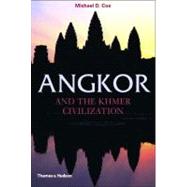
Note: Supplemental materials are not guaranteed with Rental or Used book purchases.
Purchase Benefits
What is included with this book?
| Preface | p. 7 |
| Chronological Table | p. 10 |
| Introduction | p. 11 |
| The age of 'discovery' | p. 12 |
| The Mekong Exploration Commission | p. 14 |
| The age of EFEO | p. 16 |
| The ancient Khmer Empire | p. 17 |
| The rebirth of Khmer archaeology | p. 18 |
| Periods | p. 19 |
| The Setting | p. 21 |
| The Lower Mekong Basin | p. 21 |
| The regions | p. 23 |
| Flora and fauna | p. 27 |
| Rice: the Khmer staff of life | p. 29 |
| Peoples and Languages | p. 33 |
| Cambodian genesis | p. 33 |
| The peopling of Southeast Asia | p. 33 |
| Languages: the big picture | p. 34 |
| The Khmer language | p. 38 |
| Writing | p. 39 |
| Who are the Khmer? | p. 40 |
| The Khmer Before History | p. 43 |
| Hunters and gatherers | p. 43 |
| The Early Farming period | p. 45 |
| The diffusion of rice and village life | p. 46 |
| Iron Age chiefdoms (c. 500 BC to c. AD 200-500) | p. 48 |
| The circular earthworks puzzle | p. 49 |
| The 'red soils' earthworks | p. 50 |
| Rock paintings | p. 54 |
| The Khmer before the great transformation | p. 55 |
| Winds of Change: The Early Kingdoms Period | p. 57 |
| 'Funan' and 'Zhenla' | p. 57 |
| The Delta chiefdoms | p. 61 |
| Hands across the sea | p. 62 |
| Indianization | p. 63 |
| Oc Eo and early maritime contacts | p. 64 |
| From chiefdoms to kingdoms | p. 68 |
| Angkor Borei | p. 70 |
| Sambor Prei Kuk | p. 73 |
| Banteay Prei Nokor | p. 75 |
| Wat Phu | p. 76 |
| The bronzes of Prakhon Chai | p. 78 |
| Special section: Hinduism | p. 76 |
| Special section: Buddhism | p. 85 |
| The Classic Angkor Period: From Kingdom to Empire | p. 97 |
| The founding of the Khmer Empire | p. 97 |
| Special section: Dynastic succession in Cambodia | p. 100 |
| Hariharalaya: a proto-Angkor | p. 101 |
| The 'Glory-bearing City': the founding of Angkor | p. 102 |
| Interlude at Koh Ker | p. 107 |
| Disruption and rebirth | p. 109 |
| Special section: Banteay Srei | p. 110 |
| 'Protected by the Sun': the triumph of Suryavarman | p. 112 |
| The Baphuon and the building of Phimai | p. 114 |
| Suryavarman II, builder of Angkor Wat | p. 116 |
| Special section: Angkor Wat | p. 117 |
| Disaster | p. 122 |
| Rebirth of the empire: Jayavarman VII | p. 122 |
| Reaction and iconoclasm | p. 128 |
| On the eve | p. 130 |
| The Life and Culture of Classic Angkor | p. 131 |
| The sources | p. 131 |
| The divisions of Classic Khmer society | p. 133 |
| Administration of the city and empire | p. 135 |
| Law and order in ancient Angkor | p. 144 |
| The economy | p. 145 |
| Communications and transportation | p. 151 |
| Architecture and the building trade | p. 155 |
| Arts and crafts | p. 158 |
| Daily life in ancient Angkor | p. 173 |
| Entertainment and the performing arts | p. 179 |
| Classic Khmer ritual life | p. 183 |
| Warfare and the military | p. 185 |
| Thought and culture in Classic Angkor | p. 188 |
| Angkor: city and state | p. 191 |
| The Post-Classic Period: Decline and Transformation | p. 195 |
| The collapse of Classic Angkor | p. 196 |
| The sources | p. 197 |
| Theravada Buddhism and its meaning for Cambodia | p. 201 |
| Angkor as a Theravada Buddhist complex | p. 204 |
| Geopolitics | p. 205 |
| The course of Post-Classic history | p. 208 |
| Post-Classic society and administration | p. 213 |
| Trade and commerce | p. 219 |
| Post-Classic warfare | p. 219 |
| The art of the Post-Classic | p. 220 |
| Mental life in Post-Classic Cambodia | p. 222 |
| Epilogue | p. 224 |
| Rulers of the Khmer | p. 225 |
| Visiting Angkor | p. 226 |
| Notes to the Text | p. 226 |
| Further Reading | p. 230 |
| Sources of Illustrations | p. 234 |
| Index | p. 235 |
| Table of Contents provided by Rittenhouse. All Rights Reserved. |
The New copy of this book will include any supplemental materials advertised. Please check the title of the book to determine if it should include any access cards, study guides, lab manuals, CDs, etc.
The Used, Rental and eBook copies of this book are not guaranteed to include any supplemental materials. Typically, only the book itself is included. This is true even if the title states it includes any access cards, study guides, lab manuals, CDs, etc.